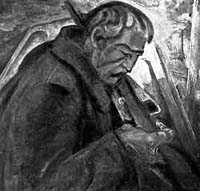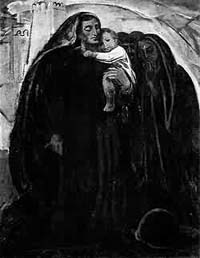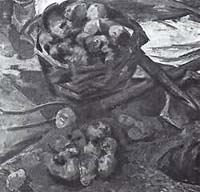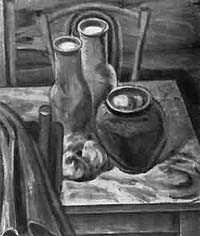 Leo Djakonitsyn
Leo Djakonitsyn
THE YOUNG, COURAGEOUS PAINTING
![]() The main treat in Shalva Mysuradze's ascetic
studio was the show of his paintings. Nowadays it is difficult to amaze exhibition-goers with something new in Art.
We have got sick and tired of a great number of artists with their "special" approaches and attitudes. That is why
the first meeting with paintings by Shalva Mysuradze in 1992 appeared happily surprising to me. His still-life works
and landscapes were of delicate and refined colours. What especially attracted in his canvases was a fresh and
correct realization of the traditions of the French and Russian painting of the beginning of the XXth century. And all
of us are fully aware of the fact that those traditions are often either forgotten or distorted. The year of 1985 was a watershed
The main treat in Shalva Mysuradze's ascetic
studio was the show of his paintings. Nowadays it is difficult to amaze exhibition-goers with something new in Art.
We have got sick and tired of a great number of artists with their "special" approaches and attitudes. That is why
the first meeting with paintings by Shalva Mysuradze in 1992 appeared happily surprising to me. His still-life works
and landscapes were of delicate and refined colours. What especially attracted in his canvases was a fresh and
correct realization of the traditions of the French and Russian painting of the beginning of the XXth century. And all
of us are fully aware of the fact that those traditions are often either forgotten or distorted. The year of 1985 was a watershed
 year for the artistic career of Mysuradze. He continued to participate in official exhibitions with his paintings depicting the
sufferings and the great victory of the Russian people in the Second World War. Having been to the front himself (from November,
1941 to May, 1945) the artist was strict and laconic in picturing the war in his monumental paintings. The central (and the best ones)
are "Parades" in which the artist took part himself. "November Parade of 1941" is more monumental representing the marching
troops by the Kremlin walls. "Victory Parade" invites the spectator to participate in it, to view it through the eyes of the soldier.
Perestroika liberated the artist, gave him an opportunity to paint freely, to evaluate his work himself Mysuradze tried new genres -
still-life and landscape. There appeared a series of bouquets and also mountain and village landscapes. From the point of view
of the expression plane, "bouquets" are represented very vaguely, almost as signs. The
year for the artistic career of Mysuradze. He continued to participate in official exhibitions with his paintings depicting the
sufferings and the great victory of the Russian people in the Second World War. Having been to the front himself (from November,
1941 to May, 1945) the artist was strict and laconic in picturing the war in his monumental paintings. The central (and the best ones)
are "Parades" in which the artist took part himself. "November Parade of 1941" is more monumental representing the marching
troops by the Kremlin walls. "Victory Parade" invites the spectator to participate in it, to view it through the eyes of the soldier.
Perestroika liberated the artist, gave him an opportunity to paint freely, to evaluate his work himself Mysuradze tried new genres -
still-life and landscape. There appeared a series of bouquets and also mountain and village landscapes. From the point of view
of the expression plane, "bouquets" are represented very vaguely, almost as signs. The
 strokes of the master's brush are sometimes
mild and delicate and sometimes wide and strong. The form is rendered perfectly: a vase is the centre of the composition,
the contrasts of bright blue and pink with cold green dominate in the colour scheme. Mysuradze's landscapes depicting the Moscow
region although spacious are very "home-like". The artist's favourite composition is a square one with a close view on the opening
landscape. But the "pearl" of the landscape collection was a series of landscapes of the Caucases, his native land. Mountains
the valleys or canyons, is the core of the artist's observations. Covered with woods, as if sleeping, the mountains are aimed at the
skies, at the eternity as an ever-lasting challenge. The stone churches are felt and depicted by the artist as an integral part of the
e rendered the sunsets and sunrises as a duel of the sun fire and eternal cold. The silhouettes of the mountains are very simple
like the quiet compositions of his still-lifes and the Moscow region landscapes, his mountains are rythmically dynamic and powerful
filled with love for life. We can hear the music - the music of the mountains and the music of painting with which the master glorifies
Nature. That was a poetic answer of Shalva Mysuradze to the vanity and chaos of today.
strokes of the master's brush are sometimes
mild and delicate and sometimes wide and strong. The form is rendered perfectly: a vase is the centre of the composition,
the contrasts of bright blue and pink with cold green dominate in the colour scheme. Mysuradze's landscapes depicting the Moscow
region although spacious are very "home-like". The artist's favourite composition is a square one with a close view on the opening
landscape. But the "pearl" of the landscape collection was a series of landscapes of the Caucases, his native land. Mountains
the valleys or canyons, is the core of the artist's observations. Covered with woods, as if sleeping, the mountains are aimed at the
skies, at the eternity as an ever-lasting challenge. The stone churches are felt and depicted by the artist as an integral part of the
e rendered the sunsets and sunrises as a duel of the sun fire and eternal cold. The silhouettes of the mountains are very simple
like the quiet compositions of his still-lifes and the Moscow region landscapes, his mountains are rythmically dynamic and powerful
filled with love for life. We can hear the music - the music of the mountains and the music of painting with which the master glorifies
Nature. That was a poetic answer of Shalva Mysuradze to the vanity and chaos of today.
 Grigoriy Anissimov
Grigoriy Anissimov
MAN OF GENEROUS SOUL
![]() Shaliko Mysuradze possessed great experience of a constantly working and thinking artist. He was always at work - even when
there at was no brush in his hand. He observed, thought and pondered over, speak about art with fellow-artists.
He was fully involved into the pursuit he considered vitally important for him. His landscapes are constructed according
the laws of colour expression, of contrastly painted surfaces, of dynamic form. The artist's absorbing attentive eyes gave
him an opportunity to paint landscapes in his studio. But take a precise look and you will see how much of Nature there
is in them! You will see the sun in the Caucases shining warmly and brightly, the green slopes of the mountains, the blue
of the endless sky, the silver of the mountain riverlets, and the sharply cut silhouettes of the old mighty trees. And all those
are integrated in
Shaliko Mysuradze possessed great experience of a constantly working and thinking artist. He was always at work - even when
there at was no brush in his hand. He observed, thought and pondered over, speak about art with fellow-artists.
He was fully involved into the pursuit he considered vitally important for him. His landscapes are constructed according
the laws of colour expression, of contrastly painted surfaces, of dynamic form. The artist's absorbing attentive eyes gave
him an opportunity to paint landscapes in his studio. But take a precise look and you will see how much of Nature there
is in them! You will see the sun in the Caucases shining warmly and brightly, the green slopes of the mountains, the blue
of the endless sky, the silver of the mountain riverlets, and the sharply cut silhouettes of the old mighty trees. And all those
are integrated in
 Mysuradze's pictures under the laws of Great Art. In his still-lifes with flowers the inner power of the Earth,
its life-giving juices are rendered through the generous combinations of red and crimson, pink and yellow, orange and blue,
black and white. Only a very gifted man with a very generous and kind soul can possess such a poetic outlook. To paint in
this way you need a strong will - and Shaliko did have it. It demanded great effort to change his artistic approach from the
narrow-sighted and wingless way of Peredvizhniki to the cubistic understanding of the sharply-silhouetted form filled in with
Sezann expressiveness. Shaliko Mysuradze managed to avoid a common desease of today's art - that is a lack of spirit and passion.
That reminds me of a XVth century architect. When he saw the building constructed by his colleague he said: "He was not able to
build well that is why he built finely". Any painting of Shaliko Mysuradze doesn't seek to impress you with the artist's mastery.
His pictures are yearning to show the world's beauty as realized by the artist. There is another peculiarity of his painting that
should be pointed out. It is abruptness - the inherent characteristic feature of a Caucasian. Only a man who was generously
gifted by the God is capable of perceiving the world in such a lively and picturesque way. The artist approached his easel with
confidence. The ability to realize his intention on the canvas made him happy. "Lead me in thy truth, and teach me: for thou
art the God of my salvation".
Mysuradze's pictures under the laws of Great Art. In his still-lifes with flowers the inner power of the Earth,
its life-giving juices are rendered through the generous combinations of red and crimson, pink and yellow, orange and blue,
black and white. Only a very gifted man with a very generous and kind soul can possess such a poetic outlook. To paint in
this way you need a strong will - and Shaliko did have it. It demanded great effort to change his artistic approach from the
narrow-sighted and wingless way of Peredvizhniki to the cubistic understanding of the sharply-silhouetted form filled in with
Sezann expressiveness. Shaliko Mysuradze managed to avoid a common desease of today's art - that is a lack of spirit and passion.
That reminds me of a XVth century architect. When he saw the building constructed by his colleague he said: "He was not able to
build well that is why he built finely". Any painting of Shaliko Mysuradze doesn't seek to impress you with the artist's mastery.
His pictures are yearning to show the world's beauty as realized by the artist. There is another peculiarity of his painting that
should be pointed out. It is abruptness - the inherent characteristic feature of a Caucasian. Only a man who was generously
gifted by the God is capable of perceiving the world in such a lively and picturesque way. The artist approached his easel with
confidence. The ability to realize his intention on the canvas made him happy. "Lead me in thy truth, and teach me: for thou
art the God of my salvation".
 Aleksey Lazykin
Aleksey Lazykin
WAY TO EASEL
Shaliko Mysuradze's small studio was ascetic: no decorations, no knick-knacks.
The master himself was always hospital, polite and tactful. Shaliko expressed his attitude towards
art straightli and definitely. It was not like him at all to go into long and amorphous nature copying.
His aim was great Art. It took him hours to make up his mind - not about WHAT to paint but HOW
to paint. In Shaliko's workshop all the canvases were facing the wall but for one which was on the easel - the one he painted adding
there or changing the colour scheme of the work. Unfortunately, the palette of the artist is lost as often happens when masters are
no longer with us. To my mind a palette can tell us a lot about an artist, about his creative approach.
A palette is a mystery of an artist's soul.
It would be great to organize an exhibition of palettes. I frequented Shaliko's workshop; we used to speak only about art never
touching upon such subjects as everyday life. He adored Deren, Matisse and Piccasso. He was never satisfied with his paintings.
abit of showing them to other artists seeking their views and assessment Probably, for his modesty he was liked and respected.
He worked to the very last day. Painting was the only meaning and purport of his life.
the easel - the one he painted adding
there or changing the colour scheme of the work. Unfortunately, the palette of the artist is lost as often happens when masters are
no longer with us. To my mind a palette can tell us a lot about an artist, about his creative approach.
A palette is a mystery of an artist's soul.
It would be great to organize an exhibition of palettes. I frequented Shaliko's workshop; we used to speak only about art never
touching upon such subjects as everyday life. He adored Deren, Matisse and Piccasso. He was never satisfied with his paintings.
abit of showing them to other artists seeking their views and assessment Probably, for his modesty he was liked and respected.
He worked to the very last day. Painting was the only meaning and purport of his life.